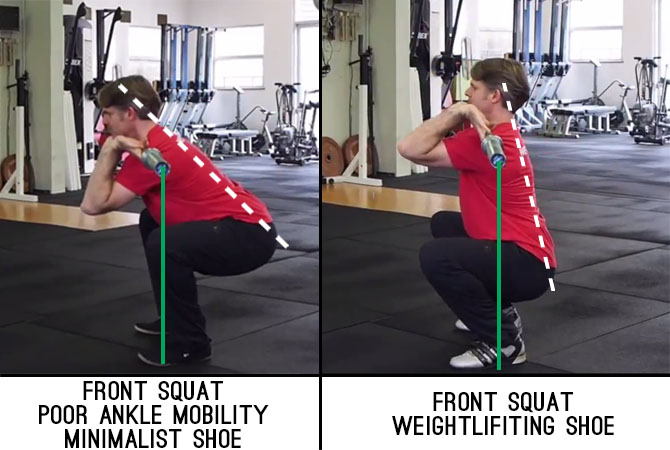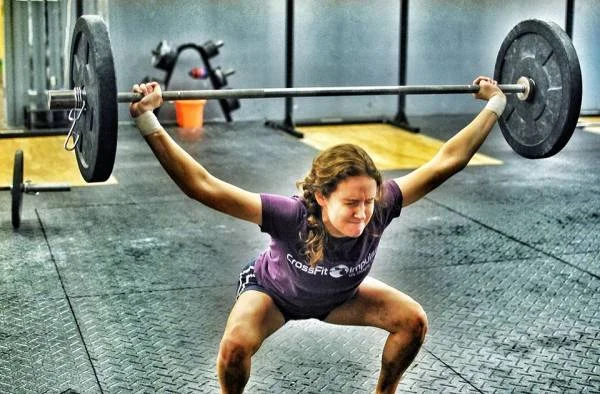A lot of people ask me if they need weightlifting shoes for CrossFit. And even when I tell them yes, they are skeptical. Often I hear that they don’t feel that they have earned their weightlifting shoes as they are not lifting heavy weights yet. Curiously, or maybe not so curiously, this is usually from newer athletes; the athlete feels they are still modified and are nervous that they would look out of place wearing this type of shoe. I can understand that. I have been known to quietly smirk at the Kool-Aid drinking CrossFit cult follower who is wearing every piece of gear designed to help him get through the WOD: tape on every finger, wrist wraps, hand grips, lifting belt, knee sleeves, compression shirt and tights, knee high socks, the newest coolest minimalist shoes, ROMWOD subscription. They can also be spotted dousing themselves with chalk, preaching about bulletproof coffee, and chugging pre-workout drinks. My husband labels this “shiny CrossFit guy”. And we have all been guilty so this is not to tease this behavior. But, I see now that there is a shying away from using these (often useful) items so as to not fall into this category and be labeled negatively.
The problem usually lies not in whether the item is useful or not, but in how or when it is used. You do not need knee sleeves, for example, when you are not going to be taxing the knees (unless you have a knee injury or osteoarthritis and prefer to keep the joint feeling snug and warm). Similarly, if you have wrist wraps on to help support your wrist, but you are wearing them incorrectly (more on this in a different post), you can actually cause more harm than good. So, this would speak to the point of the new athletes above: maybe they don’t really need them. They aren't doing a bodyweight back squat yet or don't yet feel comfortable with the techniques of Olympic lifting. I would argue that maybe the point is not that these athletes don’t need the shoes, but that they don't know when they need them.
Weightlifting shoes are helpful in offering a stable base of support for weight lifting of any sort, but they are most useful in offering assistance to athletes when squatting below parallel. In CrossFit, we consider that a full depth squat is when the hip crease goes below the knee. However, as a physical therapist, my objectives for a proper squat are:
Heel in contact with the floor
No rounding of the lumbar spine
Knees tracking over the toes
If you can hit all of these criteria and also get your squat below parallel, you are on track to getting the most out of your squat without increasing your risk for injury. If you could better achieve this position with the use of a weightlifting shoe, I say, go for it! Below is my interpretation of the four reasons you may need weightlifting shoes:
1. Ankle flexibility:
Though not always the case (and often overly labeled as the culprit), there can be a limitation in a person’s ability to fully squat relevant to their ankle mobility. The calf muscles and Achilles tendon can become tight for many reasons: genetics, injury, footwear choices, sports and physical development. Functional tests exist to screen this and can be performed by your physical therapist (consider scheduling a movement screen at Arrow Physical Therapy to learn more about your own ankles). If you have tightness in the ankle or calf, you could be limited in the ability to fully squat or you might find that you feel forward (on your toes even) in a full depth squat. A weightlifting shoe offers a raised heel which accommodates for this limitation by reducing the tension on the Achilles tendon, thus allowing the ankle joint to dorsiflex (bend). The athlete below is unable to keep his heels on the ground.
When we can adequately dorsiflex the ankle, the shins can properly position over the foot and the femur can shift back into the hip socket. If this happens correctly, we can often squat more easily, keeping chest up, trunk straight, and spine neutral. To determine if this might be you, slide two small 2.5lb plates under your heels and assess if the squat is easier, deeper, or less painful than without the plates.
2. Hip pain or tightness:
Hip pain or tightness can limit the ability to squat fully without the back rounding at the bottom of the squat. This is because if the femoral head (top of the thigh bone) cannot glide back into the socket of the pelvis, the pelvis will tuck under in order to get the body to drop the hip crease below the knees. Though this is a “good rep” and full depth, it can be painful and can cause injury to the low back and hips over time.
Because of the change in balance that is offered by the shoe (more on this below), the athlete can hinge at the hip much easier and allow that posterior glide of the femur, allowing for a more correct full depth squat. Of course there are many reasons why an athlete might lose the straight position of the spine and exhibit what we call a “butt wink” at the bottom of a squat. But, if weight lifting shoes can help to minimize this, why not give it a go and try to reach fuller, more correct squat positions so that you can strengthen and improve that position? Please note that if you are having hip pain, consider a full examination by a physical therapist who specializes in hip impingement.
3. Balance Point
Many athletes, especially those who are new to the squat, feel very forward in their squat position:
This position often gets worse when the athlete tries to progress to the overhead squat or snatch. And consequently, the victimized structure is, more often than not, the shoulder:
Mobility work with a dowel won’t correct the problem; but, a weightlifting shoe might … A weightlifting shoe positions your weight forward onto the toes. Because of this, when you hinge the hips back and start your descent into the squat, you are able to stay back on the heels (you know, the cue your coach is always screaming at you!). Neurologically, your brain recognizes that this is safe and relaxes the front of the ankle joint and hip flexors (which are often responsible for pulling you forward). Because you can sit your weight back and truly hinge at the hips, you don’t have to fight so hard to keep your trunk upward and (hopefully) the back doesn’t round at the bottom. If you can keep an upright trunk when you have the counterbalanace of a weight in front of you or the use of a doorjam or rig to support you, then this is likely a deficit in motor patterning and just needs practice. Again, the right shoe that can assist the right position, is a wonderful tool to add in so that you can get that proper practice.
4. They are designed for your sport:
In addition to the raised heel, the materials used in a lifting shoe are important. Runners run in running shoes, dancers dance in ballet slippers, character heels, a pointe shoe, or other specific shoes designed for their type of dance. Weightlifting requires a firm, stable platform to push off from and land on. The base of a weightlifting shoe is made of wood or thermoplastic polyurethane. This material and the way the shoe is designed allow the forces to spread evenly through the sole. Notice how unstable you might feel if you are doing jerks overhead in running shoes. Those shoes are made for running and have an inbuilt cushion to absorb impact with each step you take. This is great for running, but not for weightlifting. Rather than absorb force, you need a shoe that will help you use all the force your body produces to help you move weight. The more force you can produce, the more weight you can move. (But, please note I do not recommend wearing weight lifting shoes for running or box jumps due to the inability of the shoe to offer shock absorption during these activities.)
A weight lifting shoe is not a crutch; it is a tool. If used properly, it can help you to achieve the best position for your squat and you will strengthen in this position both muscularly and neurologically. You will become better at squatting. You will get stronger, more mobile, and be able to lift more weight. Your motor patterns will improve and you won’t have to think so much about position as you go into your squat. Over time, this will become more and more natural. And many times, after working in weight lifting shoes for several months or years, you can start to squat without them and achieve a much better position. This ability becomes critical for those WODs such as “Nancy” which involve an overhead squat and running.
So, go get yourself a pair of lifters. They should last you at least 2 years and will be worth the money. Proper form is important to the longevity of your participation in your sport. Remember, a tool, not a crutch! To the CrossFitters out there: keep working hard and reach out to me if you need physical therapy help!







